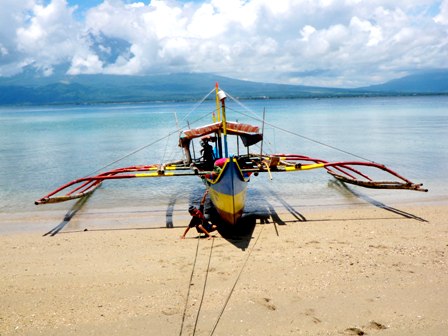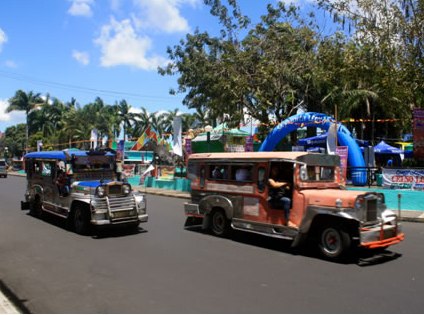
Standard class: one of the many bancas that serve the many islands
Our man in Legazpi: leisure among the 1000 islands
After a celebrated career in the service of the Australian recreation sector, Andrew Whittaker has been putting his skills and experience at the disposal of a range of development projects in south-east Asia. Here he offers an insight into a different take on a life of leisure.

Standard class: one of the many bancas that serve the many islands
Since my retirement from my post at Aquatics and Recreation Victoria in Melbourne I have been doing a lot of volunteer work in south-east Asia. Working with Australian Business Volunteers and specialising in marketing and business development, I have to date been sent on assignments to Vietnam (three times), Cambodia (twice), Thailand and Papua New Guinea.
Currently I am sitting in a hotel in Legazpi, Philippines in stinking heat trying to keep cool. The heat has caused power failures so we have had a blackout for two days and we are existing on small generators until the main power supply is restored. The hotel is right under the Mayon volcano which is the most active in the Philippines. Because of fatal accidents in the recent past they have put a six-kilometre safety zone around the volcano so you cannot climb it anymore.
I am on an assignment to help the marketing of a micro-finance organisation run by the Catholic church (Diocese of Legazpi) but I thought you might be interested in a few comments about leisure, sport and parks from the perspective of the developing nations. To be blunt, the leisure and recreation industry does not exist here in south-east Asia. You will find educated people with money who understand environmental issues and going to a health centre but for the vast bulk of people there is no provision of facilities or understanding of leisure time. I am generally working at a small business or local level and I have given up trying to explain my career as few people here can grasp the concept of a sport and recreation industry
Things like swimming pools, golf courses and fitness centres are linked to hotels or resorts but there are no public facilities like those provided by local government elsewhere. The disparity between the wealthy and the poor is huge, and those with money can enjoy leisure facilities through private clubs and exclusive arrangements. Here in the Philippines the main sport and recreation is basketball, and every village and town has a basic, crudely made court, often on dirt. However, there is action all the time, well into the night.
But the main place of leisure is the street. The houses are small and packed closely together so the street becomes the lounge room and entertainment area. It is for sitting, eating, kicking a ball, a place for kids running around and general chatter. With no welfare system the community becomes your support structure, and your spare time (leisure?) is spent interacting with them. It is a tough life for most people but I see more smiles than I do in urbanised western cities. Obesity is not a problem in south-east Asia. There may be a poor diet but westerners stand out because they are big and heavy.
The contrast between first-world and third-world perceptions are always striking. We had a blackout the other day with no power for computers or the internet, so no work. Just sitting around with some of the staff, there were some questions about my background in the sport and recreation industry. Each country makes assumptions that other people know and like their sports. It is very different here. In Australia we stop for the Melbourne Cup but Filipinos have not heard of it. However, they will stop for a boxing match. Manny Pacquiao, boxer, politician and local hero, is fighting Timothy Bradley for a world title on Sunday morning and it is anticipated that all jeepneys, tricycles and any transport will stop for the fight. Local government is setting up public viewing areas in response to massive demand from all the people who cannot afford pay TV. Just for the record nobody knew what cricket was and I did not bother to continue explaining after about 30 seconds. Some did not know that there was a football World Cup in June this year. It fascinating to see the extent to which we all live in different worlds.
Every country seems to have an iconic feature and for the Philippines the jeepney, which provide much of the local public transport, would be the recognised symbol. However, I reckon the traditional Filipino fishing boat, known as ‘banca’, should be considered. They are the main means of transporting people and cargo between islands as well being the local fishing boat. They are painted in multiple colours and a whole group of them can look very impressive and picturesque lined up on a beach. I have had a number of trips on bancas and it is quite an experience. They are not enclosed so the wind has only to get up slightly and you start getting wet from spray. Also it is not possible to bring them up to a dock as they are very wide with their outriggers so you have to get on and off from the front by dropping into the water. As the Philippines is essentially a group of 7,107 islands you need to travel on water and they are everywhere.
Andrew Whittaker is The Leisure Review's southern hemisphere correspondent and is more usually at home in Melbourne.
The Leisure Review, June 2014
© Copyright of all material on this site is retained by The Leisure Review or the individual contributors where stated. Contact The Leisure Review for details.
![]() Download a pdf version of this article for printing
Download a pdf version of this article for printing
